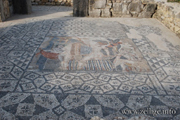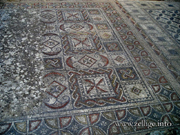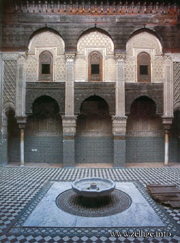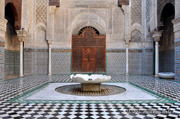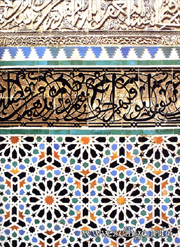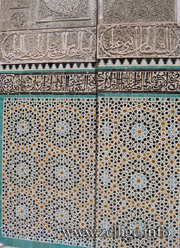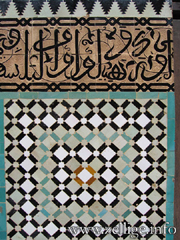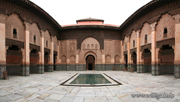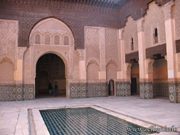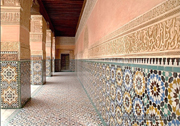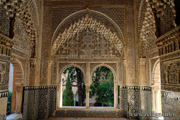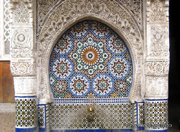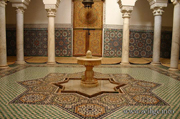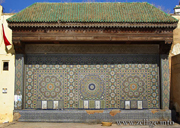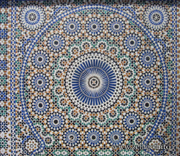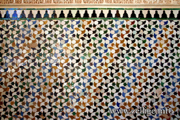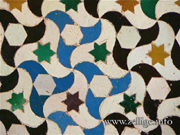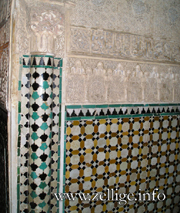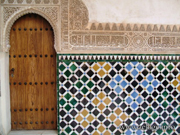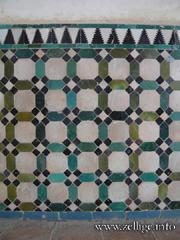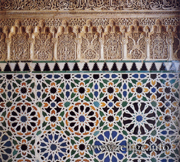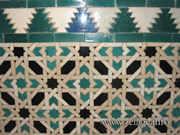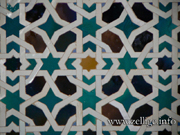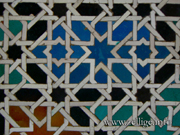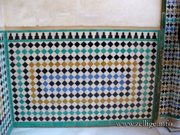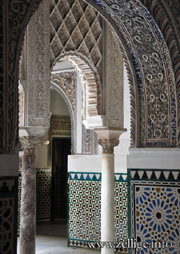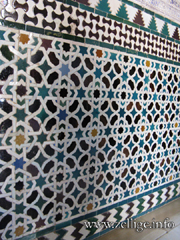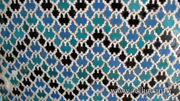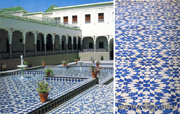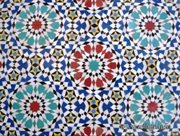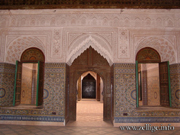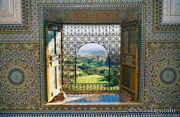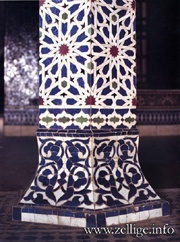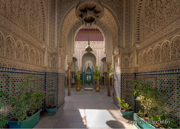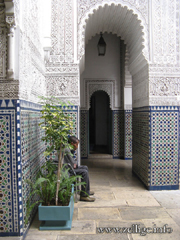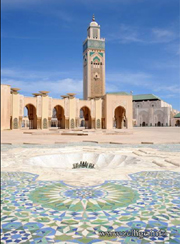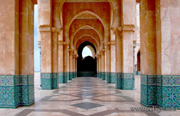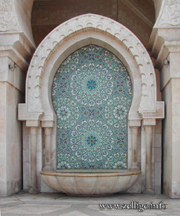
History of Moroccan Zellige
Go to photo gallery
Definition
The word "zellige" comes from Arabic الزليج ( al zulaycha ) that means « little polished stone ». This word is sometimes written zillij or zellij. This ornemantal technique is typical of Maghrebi architecture: how to assembly fragments of glazed terracotta tiles of different colours to create a geometric pattern. Sherds used are sometimes so thin that it is a true ceramic inlay.
Why "little polished stone"? Because the purpose was to imitate North Africa Greco-Roman mosaics, not by assembling pieces of polished marble ("tesserae"), but fragments of colored earthenware tiles. It is obvious that this requires less effort to cut a ceramic tile than polishing pieces of marble coming from distant sources!
The word "zellige" therefore shares the same etymology with the word azulejo used in Spain and Portugal.
Representation of human beings or animals, has often been forbidden in Islamic art. This explains the development of this decorative art governed by the geometry. Basic geometrical shapes such as squares, diamonds, triangles, stars, crosses, and other polygons are combined together according to strict mathematical patterns. Thanks to their complementarity, they form patterns that intersect and are repeated endlessly.
History
Art of zellij is born in Morocco to the tenth century, in white and brown tones, in imitation of Roman mosaics. Although the Romans no longer occupy the region for centuries, they left numerous traces. This art will be continuously enriched by the contributions of the different dynasties that succeeded in Morocco and al-Andalus, that part of Spain then under Moorish domination: the Almoravids from the desert, the Almohads from the High Atlas, and last but not least, in the fourteenth century, the Marinids, originally nomadic Berbers. During these four centuries of exchange, science and arts grow considerably. The architecture and decoration then reach their highest level of sophistication, and zellige invade the inside walls of all the palaces, tombs, fountains, patios, hammams. The colours are diversifying with the use of blue, green and yellow, red being added only in the seventeenth century.
Where to see zellige?
You can see wonderful examples of zellige in the Alhambra Palace in Granada (14th c.), the Medersa el-Attarine in Fes (14th c.), the Nejjarine fountain in Fes, the Moulay Ismail's tomb in Meknes (1700), the Medersa Ben Youssef in Marrakech (16th c.), and more recently, the Kasbah Telouet (19th c.).
This tradition is still alive as evidenced by the Hassan II Mosque in Casablanca inaugurated in 1993.
Production method
Creating zellige patterns is an art that requires expertise in mathematics and geometry. Many books highlight the rules used and their symbolism (see bibliography).
Zellige manufacturing is a work of patience and precision that mobilizes a large and experienced workforce.
Terracotta tiles are first glazed on one side. The Persians during the 9th c. discovered that tin oxide can turn opaque the glaze of earthenware. This opaque tin glaze allows the manufacture of coloured tiles with the same metallic pigments used to colour glass. Note that Europe's Renaissance will name these tiles "faience" because of the city of Faenza in Italy that was an important centre of majolica (see "glossary").
Cutting tiles is done in 3 steps: the drawing with a brush on the glazed tile of the geometric pattern (square, star, triangle, diamond, rounded shape, etc.), the manual cutting of the form by using a sharp hammer (« menqach »), and the bevelling of edges with a smaller hammer.
The final design is prepared by "zellige masters" that detail on a drawing how to assembly the shapes and colours. The cut shards are combined face down on a smooth floor, with the finest possible joints. When assembly is completed, all the tesserae are fixed by a mortar in which are sealed iron rods to ensure the solidity. Once the mortar is dry, the plate thus formed is raised and fixed on the walls.
Zellige photo gallery
-
Roman mosaic in Volubilis, Morocco
-
Roman mosaic in Volubilis, Morocco
-
Patio of Medersa el-Attarine in Fes, Morocco, zellige of the 14th c.
-
Patio with fountain of the Madrasa el-Attarine in Fes, Morocco, 1325
-
Tesselation of the Madrasa el-Attarine in Fes, Morocco, 14th c.
-
Zellige of the Madrasa Bou Inania in Fes, Morocco, Marinid dynasty, 14th c.
-
Tesselation of the Madrasa Bou Inania in Fes, Morocco, Marinid dynasty, 14th c.
-
Zellij of the inner courtyard of the Madrasa Ben Youssef in Marrakech, Morocco, Marinid dynasty, 14th c.
-
Another view of the patio with zellij of the Madrasa Ben Youssef in Marrakech, Morocco, Marinid dynasty, 14th c.
-
Detail of the zellij paneling of the Madrasa Ben Youssef in Marrakech, Morocco, 14th c.
-
Mirador in the Nasrid Palace of Alhambra in Granada, Spain, 14th c.
-
Nejjarine Fountain in Fes, Morocco, zillij from the 17th c.
-
Zellij in the Mausoleum of Moulay Ismail, Meknes, Morocco, 1703
-
Fountain in zellij of the square El-Hedime, Meknes, Morocco
-
Detail of zellige of the square El-Hedime, Meknes, Morocco
-
Tesselation of Alhambra Palace in Granada, Spain, 14th c.
-
Detail of zellige in the Alhambra Palace of Granada, Spain, 14th c.
-
Zellij from the Hall of the Ambassadors, Alhambra Palace in Granada, Spain, 14th c.
-
Paneling zellig of the Alhambra Palace in Granada, Spain, 14th c.
-
Networks of zillij imitating a wood claustra, Alhambra Palace in Granada, Spain, 14th c.
-
Detail of zellige of the Alhambra Palace in Granada, Spain
-
Detail of zellige of the Alhambra Palace in Granada, Spain
-
Detail of zellige of the Alhambra Palace in Granada, Spain
-
Detail of zellige of the Alhambra Palace in Granada, Spain
-
Detail of zellige of the Alhambra Palace in Granada, Spain
-
Zellij from the Patio de las Muñecas of the Alcazar of Seville, Spain
-
Detail of paneling zellij of the Alcazar of Seville, Spain
-
Detail of paneling zellij of the Alcazar of Seville, Spain
-
Courtyard with zellige of the Royal Palace in Fes, Morocco
-
Tesselation of the Royal Palace in Fes, Morocco
-
Kasbah of Telouet, zellige from the 19th c., Morocco
-
Kasbah of Telouet, zellige from the 19th c., Morocco
-
Detail of a pillar covered of zellij in the Kasbah of Telouet, Morocco
-
Zellij in the Palace Mahkama Pasha, Casablanca, Morocco, 20th c.
-
Zellij in the Palace Mahkama Pasha, Casablanca, Morocco, 20th c.
-
Modern zellige of the Hassan II Mosque in Casablanca, Morocco
-
Courtyard in zellige in the Hassan II Mosque in Casablanca, Morocco, 1993
-
Fountain in zellij of the Hassan II Mosque in Casablanca, Morocco




